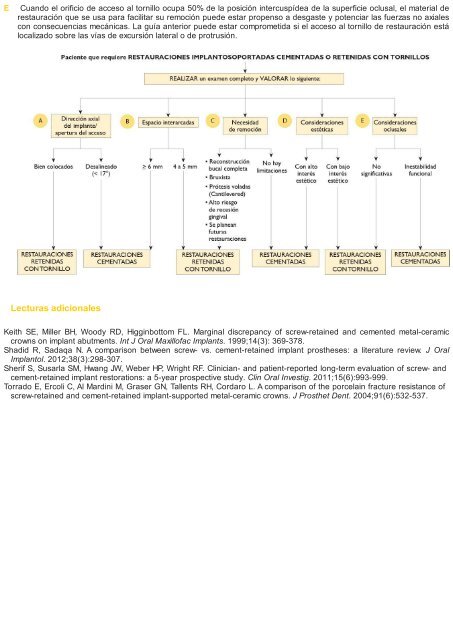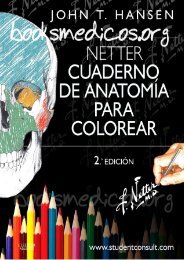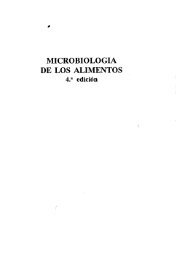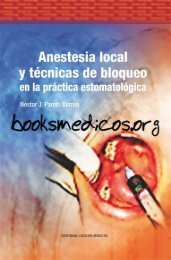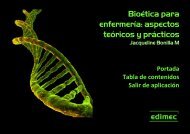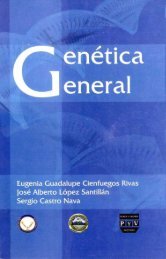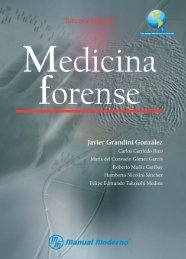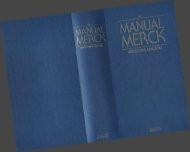- Page 2 and 3:
PRIMERA EDICIÓN EN ESPAÑOL DE LA
- Page 4 and 5:
IMPORTANTE Los autores y la Editori
- Page 6 and 7:
CONTENIDO Lista de colaboradores Pr
- Page 8 and 9:
80. Cirugía resectiva 81. Tratamie
- Page 10 and 11:
LISTA DE COLABORADORES WAYNE A. ALD
- Page 12 and 13:
Department of Preventive and Restor
- Page 14 and 15:
PETER KAWAMURA, DDS, MS Staff Geria
- Page 16 and 17:
CESAR A. MIGLIORATI, DDS, MS, PHD P
- Page 18 and 19:
EUGENE T. SANTUCCI, DDS, MA Associa
- Page 20 and 21:
ALLEN WONG, DDS, EDD Professor Dire
- Page 22 and 23:
AGRADECIMIENTOS Mi enorme agradecim
- Page 24 and 25:
PARTE I EXAMEN CLÍNICO
- Page 26 and 27:
G Los pacientes con trastornos conv
- Page 28 and 29:
HISTORIA DENTAL WALTER B. HALL La r
- Page 30 and 31:
Lecturas adicionales Newman MG, Tak
- Page 32 and 33:
Lecturas adicionales Lang NP, Lindh
- Page 34 and 35:
Figura 4-1. Radiografía de aleta d
- Page 36 and 37:
Figura 4-3. Aleta de mordida vertic
- Page 38 and 39:
pronóstico. Las raíces cortas pue
- Page 40 and 41:
menos 30%. C Los patrones de pérdi
- Page 42 and 43:
Figura 5-4. La técnica de sondeo
- Page 44 and 45:
EXAMEN PERIODONTAL GARY C. ARMITAGE
- Page 46 and 47:
SIGNOS CLÍNICOS DE SALUD GINGIVAL
- Page 48 and 49:
Figura 7-3. Inflamación gingival a
- Page 50 and 51:
El vocabulario para describir los c
- Page 52 and 53:
SANGRADO GINGIVAL M. ROBERT WIRTHLI
- Page 54 and 55:
Figura 8-2. Sangrado al sondeo que
- Page 56 and 57:
SONDEO PERIODONTAL KANOKWAN NISAPAK
- Page 58 and 59:
Figura 9-2. En el área interproxim
- Page 60 and 61:
Lecturas adicionales American Acade
- Page 62 and 63:
Figura 10-1. Anatomía interna de l
- Page 64 and 65:
Figura 10-3.Clasificación de Glick
- Page 66 and 67:
Figura 10-4B. Furca grado III de Gl
- Page 68 and 69:
Lecturas adicionales Dunlap RM, Ghe
- Page 70 and 71:
dirección 3= Movimiento dental may
- Page 72 and 73:
EVALUACIÓN OCLUSAL RICHARD T. KAO,
- Page 74 and 75:
Lecturas adicionales de Leeuw R, ed
- Page 76 and 77:
Figura 13-1. Uso inadecuado de los
- Page 78 and 79:
Figura 13-3. Agrandamiento gingival
- Page 80 and 81:
DEFECTOS ÓSEOS VERTICALES RICHARD
- Page 82 and 83:
Figura 14-3. Defecto circunferencia
- Page 84 and 85:
PARTE II DIAGNÓSTICO
- Page 86 and 87:
periodontales en sus paciente
- Page 88 and 89:
RECESIÓN GINGIVAL LISA A. HARPENAU
- Page 90 and 91:
Lecturas adicionales Miller PD Jr.
- Page 92 and 93:
Lecturas adicionales Abrams L, Pota
- Page 94 and 95:
Lecturas adicionales Abrams L, Pota
- Page 96 and 97:
Figura 19-2. Una infección localiz
- Page 98 and 99:
Figura 19-4. Un absceso periodontal
- Page 100 and 101:
Figura 19-6. En un inicio el pacien
- Page 102 and 103:
Figura 19-9. Lesión combinada endo
- Page 104 and 105:
PERIODONTITIS AGRESIVA LOCALIZADA Y
- Page 106 and 107:
AGRANDAMIENTO GINGIVAL MARIANO SANZ
- Page 108 and 109:
Lecturas adicionales American Acade
- Page 110 and 111:
E Las lesiones duras de consistenci
- Page 112 and 113:
SÍNDROME DEL DIENTE FISURADO SHANN
- Page 114 and 115:
Figura 23-3. El sondeo periodontal
- Page 116 and 117:
DIENTES CON PRONÓSTICO DESFAVORABL
- Page 118 and 119:
Lecturas adicionales Corn H, Marks
- Page 120 and 121:
GINGIVOESTOMATITIS HERPÉTICA PRIMA
- Page 122 and 123:
2004:208-211.
- Page 124 and 125:
Figura 26-1. Gingivitis descamativa
- Page 126 and 127:
Figura 26-2B. Lesión extragingival
- Page 128 and 129:
Figura 26-3A. Gingivitis descamativ
- Page 130 and 131:
Figura 26-4A. Gingivitis descamativ
- Page 132 and 133:
Figura 26-6. Corte histopatológico
- Page 134 and 135:
Figura 26-8. IFD de una lesión de
- Page 136 and 137:
Figura 26-10. IFD de pénfigo vulga
- Page 138 and 139:
Figura 26-12. Gingivitis descamativ
- Page 140 and 141:
ERUPCIÓN PASIVA ALTERADA RICHARD T
- Page 142 and 143:
Figura 27-1B. Al examen clínico, s
- Page 144 and 145:
Figura 27-1E. Vista posoperatoria e
- Page 146 and 147:
BIOTIPO GINGIVAL GRUESO CONTRA DELG
- Page 148 and 149:
Cuadro 28-1. Características del b
- Page 150 and 151:
Cuadro 28-2. Características del b
- Page 152 and 153:
Figura 28-4. En el biotipo gingival
- Page 154 and 155:
INTERRELACIÓN ENTRE LAS ENFERMEDAD
- Page 156 and 157:
DIFERENCIACIÓN DEL DOLOR ENDODÓNC
- Page 158 and 159:
Brannström M. The hydrodynamic the
- Page 160 and 161:
ESTUDIOS COMPLEMENTARIOS DE LABORAT
- Page 162 and 163:
filtración hepática; por ello, se
- Page 164 and 165:
ANÁLISIS MICROBIANO MICHAEL G. JOR
- Page 166 and 167:
Figura 32-2. Para la toma de muestr
- Page 168 and 169:
Figura 32-4. A cada frasco se le de
- Page 170 and 171:
Figura 32-6. El frasco y la solicit
- Page 172 and 173:
PRUEBA GENÉTICA DE INTERLEUCINA I
- Page 174 and 175:
la fase de tratamiento activa, adem
- Page 176 and 177:
PARTE IV CONSIDERACIONES DEL PLAN D
- Page 179 and 180:
Lecturas adicionales McGuire MK. Pr
- Page 181 and 182:
Figura 35-1A. Necrosis pulpar que c
- Page 183 and 184:
Figura 35-1C. Radiografía donde se
- Page 185 and 186:
Figura 35-2B. Un absceso periodonta
- Page 187 and 188:
en la etapa de celulitis. Los antib
- Page 189 and 190:
Figura 35-5B. La causa principal de
- Page 191 and 192:
ANÁLISIS DE LOS FACTORES DE RIESGO
- Page 193 and 194:
C Cuando se han determinado los fac
- Page 195 and 196:
CONDICIONES LEGALES DEL TRATAMIENTO
- Page 197 and 198:
Lecturas adicionales Armitage GC. D
- Page 199 and 200:
H Después de la revaloración y de
- Page 201 and 202:
dos formas: localizada y generaliza
- Page 203 and 204:
Lecturas adicionales ADA/PDR Guide
- Page 205 and 206:
Figura 41-1. La anchura de la encí
- Page 207 and 208:
VALORACIÓN DE PILARES PROTÉSICOS
- Page 209 and 210:
Figura 42-3. Al paciente le falta u
- Page 211 and 212:
CONSIDERACIONES DEL PLAN DE TRATAMI
- Page 213:
Figura 43-1.Ejemplo de un caso parc
- Page 216 and 217:
Lecturas adicionales Bergman B, Hug
- Page 218 and 219:
FACTORES EXTERNOS: CONSIDERACIONES
- Page 220 and 221:
FACTORES EXTERNOS: CONSIDERACIONES
- Page 222 and 223:
común es que está comprometida la
- Page 224 and 225:
FACTORES EXTERNOS: CONSIDERACIONES
- Page 226 and 227:
McGuire MK, Nunn ME. Prognosis vers
- Page 228 and 229:
Lecturas adicionales Gartrell JR, M
- Page 230 and 231:
que sienten y el tratamiento corres
- Page 232 and 233:
MANEJO DEL PACIENTE GERIÁTRICO PET
- Page 234 and 235:
perder varios dientes, la colocaci
- Page 236 and 237:
antibióticos sistémicos pueden in
- Page 238 and 239:
MANEJO DEL PACIENTE DE SEXO FEMENIN
- Page 240 and 241:
Lecturas adicionales American Denta
- Page 242 and 243:
Figura 52-1. Gingivitis del embaraz
- Page 244 and 245:
presentarse el síndrome de hiperte
- Page 246 and 247:
medicamentos, cada uno de los cuale
- Page 248 and 249:
Lecturas adicionales Lamster IB, La
- Page 250 and 251:
preocupación por presentar oste
- Page 252 and 253:
higienista dental que sus médicos,
- Page 254 and 255:
MANEJO DEL PACIENTE PEDIÁTRICO A.J
- Page 256 and 257:
Lecturas adicionales American Acade
- Page 258 and 259:
Figura 57-2. Valoración una semana
- Page 260 and 261:
MANEJO DEL PACIENTE CON CÁNCER SOL
- Page 262 and 263:
MANEJO DEL PACIENTE CON NECESIDADES
- Page 264 and 265:
9. Kinane DF, Hajishengallis G. Pol
- Page 266 and 267:
proporcionada le deberá permitir a
- Page 268 and 269:
que: 1) la información que quiere
- Page 270 and 271:
PARTE V TERAPIA INICIAL Y USO DE AU
- Page 272 and 273:
para producir anestesia profunda de
- Page 274 and 275:
G Si existe una enfermedad persiste
- Page 276 and 277:
Lecturas adicionales American Acade
- Page 278 and 279:
de restauración final deberá real
- Page 280:
DESBRIDACIÓN, TRATAMIENTO Y MANTEN
- Page 289 and 290:
Figuras 66-2A-D. Resección radicul
- Page 291 and 292:
CEPILLOS ELÉCTRICOS CONTRA CEPILLO
- Page 293 and 294:
AUXILIARES PARA EL CONTROL DE PLACA
- Page 295 and 296:
10) así como para aplicar flúor o
- Page 297 and 298:
también es usado en el tratamiento
- Page 299 and 300:
Lecturas adicionales ADA/PDR Guide
- Page 301 and 302:
La selección empírica de antibió
- Page 303 and 304:
GUÍA CANINA CONTRA FUNCIÓN DE GRU
- Page 305 and 306:
DESGASTE DENTAL SELECTIVO Y USO DE
- Page 307 and 308:
Harrel SK, Nunn ME. The effect of o
- Page 309 and 310:
decida utilizarla, el odontólogo d
- Page 311 and 312:
REVALORACIÓN PERIODONTAL LISA A. H
- Page 313 and 314:
TRATAMIENTO PERIODONTAL DE MANTENIM
- Page 315 and 316:
PARTE VI TRATAMIENTO PERIODONTAL RE
- Page 317 and 318:
procedimientos de reducción de bol
- Page 319 and 320:
DISEÑO DEL COLGAJO QUIRÚRGICO LEO
- Page 321 and 322:
CIRUGÍA ÓSEA LEONARD S. TIBBETTS
- Page 323 and 324:
CIRUGÍA RESECTIVA LEONARD S. TIBBE
- Page 325 and 326:
TRATAMIENTO DE LOS DEFECTOS RETROMO
- Page 327 and 328:
Figura 81-2. Para defectos infraós
- Page 329 and 330:
Lecturas adicionales Kao RT. Period
- Page 331 and 332:
Figura 82-1. Dimensiones promedio d
- Page 333 and 334:
Becker W, Ochsenbein C, Becker BE.
- Page 335 and 336:
diente que está próximo a una fur
- Page 337 and 338:
Figura 84-1. (A) Vista previa al tr
- Page 339 and 340:
Figura 84-2. (A) La paciente tenía
- Page 341:
SECUENCIA DE TRATAMIENTO PARA LA PE
- Page 344 and 345:
agresiva pueden ser el Aggregatibac
- Page 346 and 347:
la enfermedad sea recurrente, y que
- Page 348 and 349:
Figura 86-1. Apariencia preoperator
- Page 350 and 351:
INDICACIONES PARA RESECCIÓN RADICU
- Page 352 and 353:
CIRUGÍA MÍNIMAMENTE INVASIVA STEP
- Page 354 and 355:
Figura 88-3. Vista en un videoscopi
- Page 356 and 357:
Figura 88-5. El injerto óseo es co
- Page 358 and 359:
PARTE VII TRATAMIENTO PERIODONTAL R
- Page 360 and 361:
Figura 89-2. (Comenzar en la parte
- Page 362 and 363:
Gurinsky BS, Mills MP, Mellonig JT.
- Page 364 and 365:
Figura 90-1. Vista preoperatoria de
- Page 366 and 367:
Figura 90-3. Defecto óseo con comp
- Page 368 and 369:
Figura 90-5. Diseño de un colgajo
- Page 370 and 371:
Figura 90-7. Resultado posoperatori
- Page 372 and 373:
apropiadamente mediante la reposici
- Page 374 and 375:
egenerative procedures. J Periodont
- Page 376 and 377:
paredes, o una combinación de un d
- Page 378 and 379:
Figura 91-3. Radiografía posoperat
- Page 380 and 381:
PROCEDIMIENTOS REGENERATIVOS DE REL
- Page 382 and 383:
Lecturas adicionales Gantes B, Mart
- Page 384 and 385:
PROCEDIMIENTOS REGENERATIVOS CON CO
- Page 386 and 387:
no requiera ostectomía excesiva qu
- Page 388 and 389:
REGENERACIÓN TISULAR GUIADA DESPU
- Page 390 and 391:
PARTE VIII CIRUGÍA MUCOGINGIVAL
- Page 392 and 393:
Figura 95-1A. Recesión Clase I de
- Page 394 and 395:
Figura 95-1C. Fueron realizadas dos
- Page 396 and 397:
Figura 95-1F. Posquirúrgico a las
- Page 398 and 399:
Figura 95-1H. Posquirúrgico al añ
- Page 400 and 401:
Figura 95-2C. Después de la desbri
- Page 402 and 403:
Figura 95-2E. Posquirúrgico a los
- Page 404 and 405:
Figura 95-3B. Se disecó la mucosa
- Page 406 and 407:
Figura 95-3E. Posquirúrgico a los
- Page 408 and 409:
1978;49(7):351-356. Harris RJ. Ging
- Page 410 and 411:
señalados en el inciso F o G depen
- Page 412 and 413:
de doble papila. Lo que asegura mej
- Page 414 and 415: Lecturas adicionales Bohannan HM. S
- Page 416 and 417: Figura 98-1. Recesión y erosión/a
- Page 418 and 419: Lecturas adicionales Goldstein M, N
- Page 420 and 421: Figura 99-1 A. Cicatrización 2 sem
- Page 422 and 423: Figura 99-1 C. Cicatrización del s
- Page 424 and 425: Figura 99-1 E. Se le agregó compos
- Page 426 and 427: Lecturas adicionales Harris RJ. Sof
- Page 428 and 429: SELECCIÓN DEL MATERIAL PARA SUTURA
- Page 430 and 431: Cohen ES. Sutures and suturing. In:
- Page 432 and 433: por una cubierta de papel; después
- Page 434 and 435: MANEJO FARMACOLÓGICO DEL DOLOR PER
- Page 436 and 437: Lecturas adicionales ADA/PDR Guide
- Page 438 and 439: neurovasculatura en el área quirú
- Page 440 and 441: HIPERSENSIBILIDAD DENTINARIA WILLIA
- Page 442 and 443: PARTE X IMPLANTES DENTALES
- Page 444 and 445: Lecturas adicionales Curley A, Hatc
- Page 446 and 447: Con los avances que se han document
- Page 448 and 449: SELECCIÓN DE MATERIALES DE REGENER
- Page 450 and 451: Figura 107-3. Vista posoperatoria d
- Page 452 and 453: MANEJO DEL RIESGO EN IMPLANTES MICH
- Page 454 and 455: Misch CE. Contemporary Implant Dent
- Page 456 and 457: Lecturas adicionales Hämmerle CH,
- Page 458 and 459: Lecturas adicionales Kinsel RP, Lin
- Page 460 and 461: Lecturas adicionales Grossmann Y, F
- Page 462 and 463: Lecturas adicionales Allen F, McMil
- Page 468 and 469: Figura 114-1. Radiografía panorám
- Page 470 and 471: Figura 114-3. Asimetría gingival e
- Page 472 and 473: Figura 114-5. Periodonto grueso con
- Page 474 and 475: Lecturas adicionales Becker W, Ochs
- Page 476 and 477: Figura 115-2. Colocación de la res
- Page 478 and 479: Sammartino G, Marenzi G, di Lauro A
- Page 480 and 481: Figura 116-1A. Extracción, incluso
- Page 482 and 483: Figura 116-1C. La raíz extraída f
- Page 484 and 485: Figura 116-2B. El defecto fue relle
- Page 486 and 487: Figura 116-3A.Los defectos extensos
- Page 488 and 489: Figura 116-3C. Reentrada a los 6 me
- Page 490 and 491: COLOCACIÓN INMEDIATA DEL IMPLANTE
- Page 492 and 493: MANEJO DE LOS TEJIDOS DURANTE LA CO
- Page 494 and 495: Figura 118-1B. Se muestra la coloca
- Page 496 and 497: Figura 118-1D. Implante expuesto; s
- Page 498 and 499: Figura 118-1F. Radiografía de la r
- Page 500 and 501: PRESERVACIÓN DE LAS DIMENSIONES DE
- Page 502 and 503: Figura 119-2. Procedimiento de pres
- Page 504 and 505: extraction. Report of 10 cases. J P
- Page 506 and 507: E Los defectos en un reborde estrec
- Page 508 and 509: Figura 120-1C. Sitio después del a
- Page 510 and 511: Figura 120-1E. Reentrada al sitio q
- Page 512 and 513: Figura 120-1G. Implante con su rest
- Page 514 and 515:
Lecturas adicionales Araújo MG, Li
- Page 516 and 517:
D Cuando son necesario incrementos
- Page 518 and 519:
Figura 121-1C. Se muestra un bloque
- Page 520 and 521:
Figura 121-1E. Muestra la colocaci
- Page 522 and 523:
Lecturas adicionales Esposito M, Gr
- Page 526 and 527:
Figura 122-1. Plantilla radiológic
- Page 528 and 529:
cuya elaboración están incluidos
- Page 530 and 531:
Lecturas adicionales Danforth RA, P
- Page 532 and 533:
menos tiempo de consulta, especialm
- Page 534 and 535:
Figura 124-1. Mini implantes usados
- Page 536 and 537:
primarios y secundarios, e incluso
- Page 538 and 539:
TERAPIA DE MANTENIMIENTO PARA IMPLA
- Page 540 and 541:
ETIOLOGÍA DE LA PERIIMPLANTITIS MA
- Page 542 and 543:
Lecturas adicionales Froum SJ. Dent
- Page 544 and 545:
más conservador. En este caso, el
- Page 546 and 547:
tratamiento correctivo. En este mom
- Page 548 and 549:
DISEÑO DE SONRISA DESDE LA PERSPEC
- Page 550 and 551:
Figura 129-2. Los bordes incisales
- Page 556 and 557:
Figura 129-4A-E. Malformación esqu
- Page 558 and 559:
Figura 129-6A. En este caso había
- Page 560 and 561:
estética. El tratamiento interdisc
- Page 562 and 563:
Figura 130-1. Proporción ideal de
- Page 564 and 565:
Lecturas adicionales Chiche G, Pina
- Page 566 and 567:
Figura 131-2. Línea labial baja C
- Page 568 and 569:
Lecturas adicionales Dolt AH, Robbi
- Page 570 and 571:
Lecturas adicionales Chu S, Karabin
- Page 572 and 573:
Lecturas adicionales Allen EP. Use
- Page 574 and 575:
Figura 134-2. Con una sonda 3 a 6 a
- Page 576 and 577:
Figura 134-5. Elevación de un colg
- Page 578 and 579:
Lecturas adicionales Allen EP. Surg
- Page 580 and 581:
Figura 135-1. Exposición radicular
- Page 582 and 583:
Figura 135-4. Se logró una cobertu
- Page 584 and 585:
COLOCACIÓN DEL MARGEN DE LA CORONA
- Page 586 and 587:
Figura 136-2. La violación de la a
- Page 588 and 589:
del implante. Los clínicos pueden
- Page 590 and 591:
Lecturas adicionales Berglundt T, L
- Page 592 and 593:
TRATAMIENTOS ORTODÓNCICOS PARA PAC
- Page 594 and 595:
Lecturas adicionales Bollen AM, Cun
- Page 596 and 597:
crecimiento incontrolado de tejido
- Page 598 and 599:
TRAUMA OCLUSAL Y ORTODONCIA EN PACI
- Page 600 and 601:
Figura 139-3. Bruxismo y deficienci
- Page 602 and 603:
depende de la valoración del estad
- Page 604 and 605:
Knight DJ, Leroux BG, Zhu C, Almond
- Page 606 and 607:
Lecturas adicionales Kugelberg CF,
- Page 608 and 609:
Lecturas adicionales Braden BE. Dee
- Page 610 and 611:
Lecturas adicionales Eversole LR. C
- Page 612 and 613:
CONSIDERACIONES DENTALES DE UN TERC
- Page 614 and 615:
EFECTOS DEL ENVEJECIMIENTO Y DE LA
- Page 616:
Endod. 1979;5(8):242- 253. Langelan


